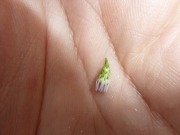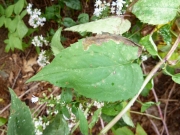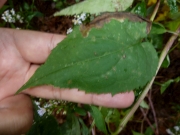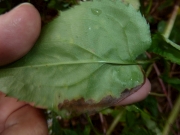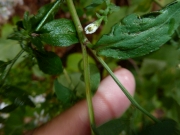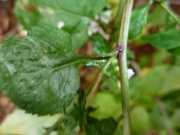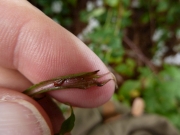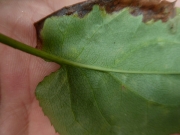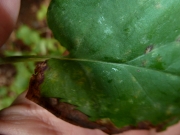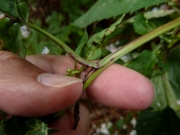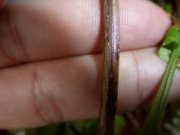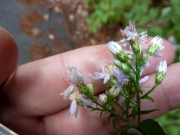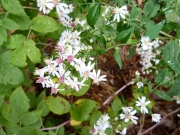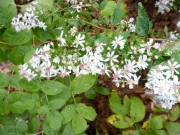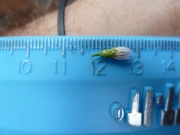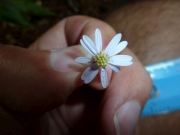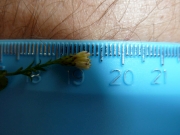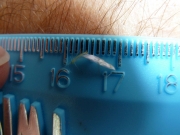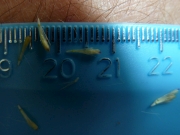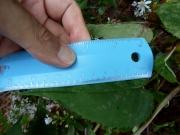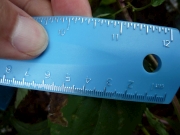Transformational Gardening
September 2011 Foraging Experiences
(Back to:
August 2011 Foraging Experiences)
(Forward to:
October 2011 Foraging Experiences)
September 2, 2011
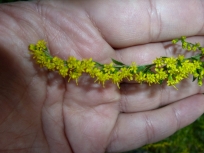
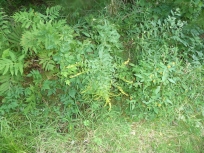 In New England, there are only three triple-nerved goldenrods (3 main leaf veins)
where the leaf size and shape are nearly the same all of the way up and down the stem.
In New England, there are only three triple-nerved goldenrods (3 main leaf veins)
where the leaf size and shape are nearly the same all of the way up and down the stem.
- Canada Goldenrod (Solidago canadensis)
- Giant Goldenrod (Smooth Goldenrod) (Solidago gigantea)
- Tall Goldenrod (Solidago altissima also known as Solidago canadensis var.
scabra)
The medicinal tea is anti-inflammatory, anti-yeast and anti-catarrh (makes mucous more
liquid). The saponins in the goldenrod are a urinary tract antiseptic. Make tea from
dried leaves and flowers. Tall, straight stalks can be used as a hand-drill for making
fire.
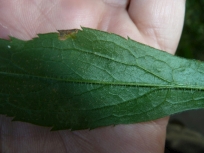
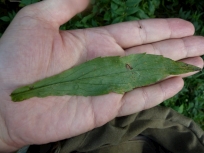 Giant Goldenrod has a smooth, hairless, glaucous (whitish, waxy coating) stem. Leaves
are hairless except for the three main veins on the underside of the leaf. Tall Goldenrod
is classified as one of the variations of Canada Goldenrod. Var. canadensis
and Var. salebrosa are sparsely hairly on the upper half of the stem and the
lower half is mostly hairless. Var. gilvocanescens has leaves that are spreading
hairly on the upper and lower surfaces and the leaves are 3.5 to 7 cm long.
Var. scabra and Var. hargeri have leaves over 7 cm long, stems are very
hairy throughout and upper surface of leaves merely rough to the touch, but not very hairy.
Var. scabra has larger and fewer disk flowers than Var. hargeri. Flower
rays average 13, leaves are firm and shallowly-toothed or entire (untoothed). Var.
hageri has thin leaves that are sharply toothed and sometimes entire.
Giant Goldenrod has a smooth, hairless, glaucous (whitish, waxy coating) stem. Leaves
are hairless except for the three main veins on the underside of the leaf. Tall Goldenrod
is classified as one of the variations of Canada Goldenrod. Var. canadensis
and Var. salebrosa are sparsely hairly on the upper half of the stem and the
lower half is mostly hairless. Var. gilvocanescens has leaves that are spreading
hairly on the upper and lower surfaces and the leaves are 3.5 to 7 cm long.
Var. scabra and Var. hargeri have leaves over 7 cm long, stems are very
hairy throughout and upper surface of leaves merely rough to the touch, but not very hairy.
Var. scabra has larger and fewer disk flowers than Var. hargeri. Flower
rays average 13, leaves are firm and shallowly-toothed or entire (untoothed). Var.
hageri has thin leaves that are sharply toothed and sometimes entire.
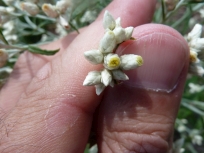
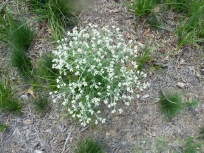 There are only a handful of plants I can find listed as growing in
New Hampshire that look anything like this one:
There are only a handful of plants I can find listed as growing in
New Hampshire that look anything like this one:
- Western Pearly Everlasting (Anaphalis margaritacea): More rounded flower
heads with some outer white bracts spreading open.
- Woman’s Tobacco (Antennaria plantaginifolia): Pussytoes like flowers,
basal, plantain-like leaves.
- Marsh Cudweed (Gnaphalium uliginosum): Leaves grow only to 4 cm long.
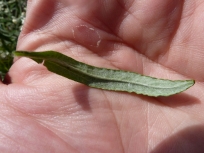
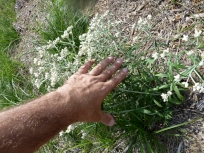
- Alpine Arctic Cudweed (Omalotheca supina): Alpine plant. Leaves grow only to
2.5 cm long. Tight clusters of brown flowerheads.
- Woodland Arctic Cudweed (Omalotheca sylvatica): Long, thin leaves. Flower
heads with dark green bracts bunch in terminal and axillary clusters up the stem.
- Macoun’s Cudweed (Pseudognaphalium macounii): Leaf blades extend
downwards after attaching to the stem (decurrent). Glandular-hairy stem and
wooly white hairs only near the inflorescence.
- Heller’s Cudweed (Pseudognaphalium helleri): Glandular-hairy stem and
wooly white hairs only near the inflorescence. Leaves not distinctly decurrent. (See
Pseudognaphalium macounii above.)
- Rabbit Tobacco (Pseudognaphalium obtusifolium): Seems to match this plant.
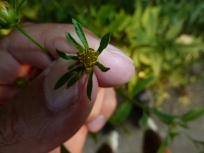
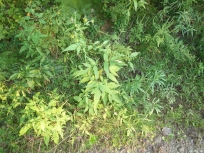 In New Hampshire, there are only a few plants of the Bidens genus with odd
pinnately-compound leaves. That means that along each leaf is one or more sets of
opposite leaflets and the leaf ends in a terminal leaflet (making an odd number of
leaflets):
In New Hampshire, there are only a few plants of the Bidens genus with odd
pinnately-compound leaves. That means that along each leaf is one or more sets of
opposite leaflets and the leaf ends in a terminal leaflet (making an odd number of
leaflets):
- Bearded Beggarticks (Bidens aristosa): Flower head with well-developed
rays.
- Small Beggarticks (Bidens discoidea): 3-5 outer bracts that are not
ciliate.
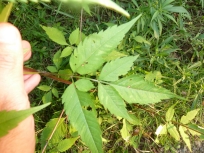
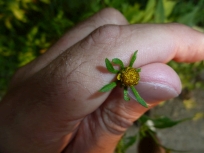
- Big Devil’s Beggarticks (Bidens vulgata): 10-16 (typically 13)
outer bracts that are ciliate.
- Devil’s Beggarticks (Bidens frondosa): This plant. 5-10 outer bracts,
(typically 8) that are ciliate.
September 5, 2011
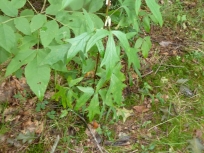
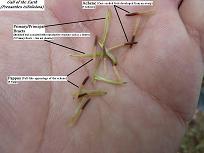
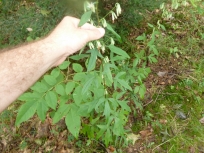
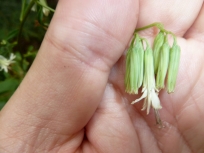
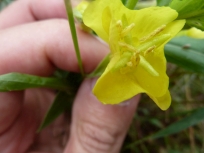
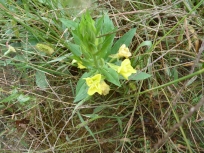
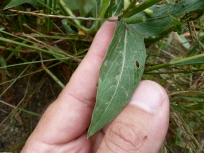
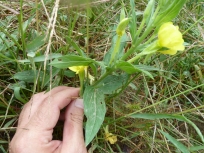
September 6, 2011
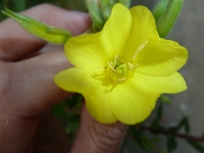
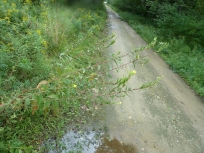 The plants I encountered were 5 to 7 feet tall. In New Hampshire, there are only a few
species of Evening Primrose that are very tall (over 4 feet tall).
The plants I encountered were 5 to 7 feet tall. In New Hampshire, there are only a few
species of Evening Primrose that are very tall (over 4 feet tall).
- Northern Evening Primrose (Small Flower Evening Primrose)
(Oenothera parviflora): Very similar to Common Evening Primrose. The main
difference is that the two sepal tip appendages on Common Evening Primrose begin at
the apex of the sepal. For Northern Evening Primrose, the two sepal tip appendages
begin before the apex of the sepal. Click on first picture in 2nd row for details.
- Redsepal Evening Primrose (Oenothera glazioviana): The flower of
Redsepal Evening Primrose is much bigger -- flower petals being 3-5 cm tall and sepals
are red. Often seen in gardens, sparingly escaped into the wild.
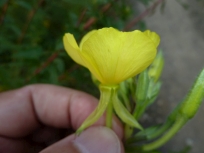
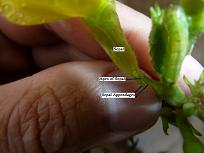
- Oakes’ Evening Primrose (Oenothera oakesiana)
(Synonym: Oenothera parviflora var. angustissima): Oakes Evening Primrose is
considered a variation of Northern Evening Primrose (Oenothera parviflora) (see
above). Therefore, the sepal tip appendages begin before the apex of the sepal. It has
short, stiff white/gray and appressed hairs without having glandular hairs.
- Common Evening Primorose (Oenothera biennis): This plant. Notice that
the two sepal appendages grow out of the apex of the sepal.
- Hairy Evening Primrose (Oenothera villosa) (Synonyms:
Oenothera biennis var. canescens, Oenothera strigosa): Hairy Evening Primrose
is often considered a variation of Common Evening Primorose (Oenothera biennis).
It is densely-covered with grayish stiff hairs that can either be short or long and has
few or no gland-tipped hairs.
In order to limit the list of Evening Primrose to the above five possibilities,
rather than using the plant height, I used the Key provided in
the book,
Manual of Vascular Plants of Northeastern United States and Adjacent Canada. This
plant has roundly 4-angled fruit (not sharply 4-angled fruit), yellow flowers and
the fruit is thickest at the base and tapers (not linear).
I took quite a few pictures and measurements of this plant. You can see that the
leaves are around 12 cm long and 3.8 cm wide. The seeds are approximately 1.2 mm long.
The flower petals are 1.8 cm high and approximately the same width. The sepals + sepal
appendages are nearly 3 cm long. The sepal appendages are 5 mm long. This plant was
7-1/2 feet tall!
September 10, 2011
My Panasonic Lumix DMC-ZS7 camera broke again! The closeup pictures
that it takes are excellent and often very crisp. But the lens motor breaks
regularly even with keeping the camera in a cushioned case. The pictures
below are taken with a Canon Powershot SX130 which is built like a tank, but
the pictures are not as crisp. Crisp closeup pictures are crucial for seeing
hairs on plant parts and other details.
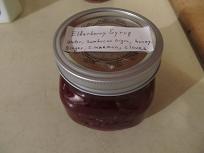
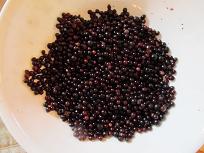 I made 2-1/2 pints of Elderberry syrup following the
Mountain Rose Herbs
video instructions. I used 1/2 cup of honey on the second batch because it is too
sweet with 1 cup of honey per 1 cup of fresh elderberries.
I made 2-1/2 pints of Elderberry syrup following the
Mountain Rose Herbs
video instructions. I used 1/2 cup of honey on the second batch because it is too
sweet with 1 cup of honey per 1 cup of fresh elderberries.
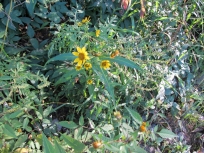
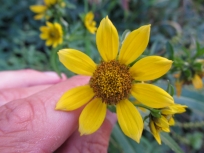
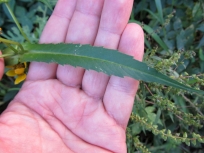
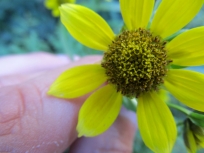
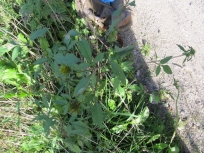
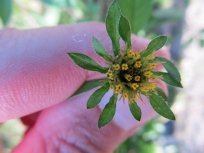 In New Hampshire, there are only a few plants of the Bidens genus with odd
pinnately-compound leaves. That means that along each leaf is one or more sets of
opposite leaflets and the leaf ends in a terminal leaflet (making an odd number of
leaflets):
In New Hampshire, there are only a few plants of the Bidens genus with odd
pinnately-compound leaves. That means that along each leaf is one or more sets of
opposite leaflets and the leaf ends in a terminal leaflet (making an odd number of
leaflets):
- Bearded Beggarticks (Bidens aristosa): Flower head with well-developed
rays.
- Small Beggarticks (Bidens discoidea): 3-5 outer bracts that are not
ciliate.
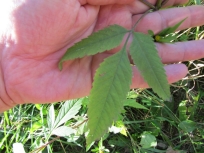
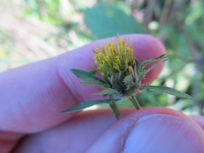
- Devil’s Beggarticks (Bidens vulgata): 5-10 outer bracts,
(typically 8) that are ciliate.
- Big Devil’s Beggarticks (Bidens vulgata): This plant.
10-16 (typically 13) outer bracts that are ciliate.
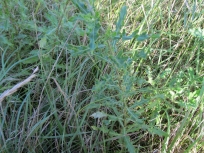
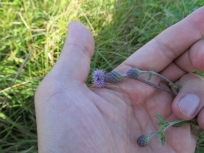
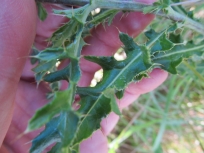
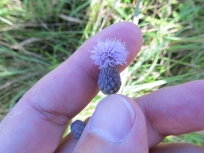
Arrowleaf Tearthumb (Persicaria meisneriana (Polygonum sagittatum))

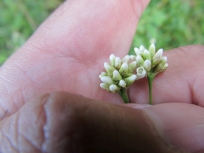 The stem of this plant has an amazingly sticky feel due to the rows of tiny hooked
barbs. See the first image on the 2nd row below.
The stem of this plant has an amazingly sticky feel due to the rows of tiny hooked
barbs. See the first image on the 2nd row below.
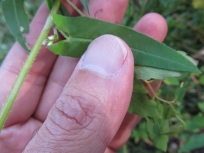
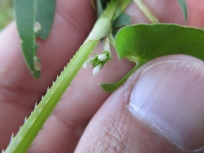
September 11, 2011
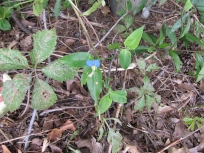
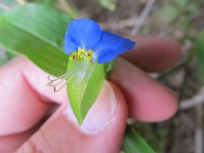
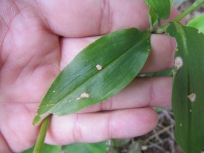
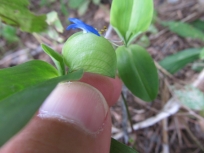
Kalm’s Hawkweed (Hieracium kalmii var. kalmii)
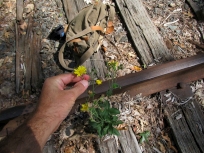
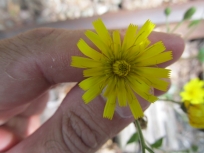
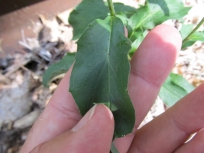
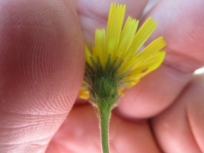
September 13, 2011
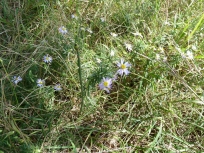
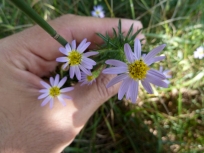
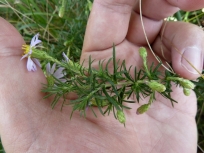
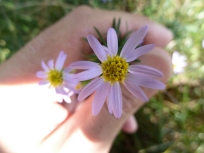
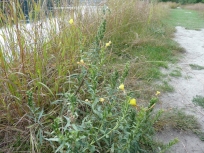
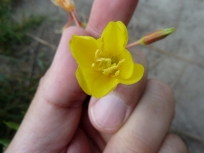 This evening primrose had fruit that is round-angled (not squarish, sharply-angled like
Meadow Evening Primrose (Oenothera pilosella). The fruit is thickest near the
base and tapers. The flowers are yellow. This means that the plant was either
Common Evening Primrose (Oenothera biennis) (or one of its variations) or
Northern Evening Primrose (Oenothera pariflora) (or one of its variations). The
main differences appear to be the size of the seeds and how the two sepal appendages
connect to the sepal.
This evening primrose had fruit that is round-angled (not squarish, sharply-angled like
Meadow Evening Primrose (Oenothera pilosella). The fruit is thickest near the
base and tapers. The flowers are yellow. This means that the plant was either
Common Evening Primrose (Oenothera biennis) (or one of its variations) or
Northern Evening Primrose (Oenothera pariflora) (or one of its variations). The
main differences appear to be the size of the seeds and how the two sepal appendages
connect to the sepal.
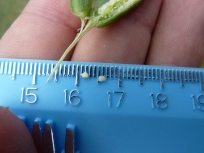
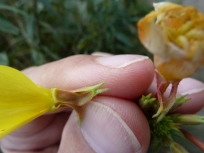 Looking at the picture on the left hand side of the 2nd row, it appears that the two
sepal appendances connect below the apex of the sepal. The apex of the sepal
is the point furthest away from where the sepal attaches to the flower. There is a
significant-sized ridge at the apex of the sepal and the appendances are attached
beneath that ridge.
Looking at the picture on the left hand side of the 2nd row, it appears that the two
sepal appendances connect below the apex of the sepal. The apex of the sepal
is the point furthest away from where the sepal attaches to the flower. There is a
significant-sized ridge at the apex of the sepal and the appendances are attached
beneath that ridge.
In addition, the seeds of Common Evening Primrose are 1.2 to 1.8 mm long and the seeds
of Northern Evening Primrose are 1.8 to 2.2 mm long. As you can see from the picture on
the right of the second row, it appears that the seeds are approximately 1.8 to 1.9 mm
long when measuring from the center of each black hash mark that represents 1 mm.
Finally, a variation of Northern Evening Primrose is Oakes Evening Primrose
(Oenothera oakesiana). Oakes Evening Primrose, which is found primarily from
Massachusetts and south to Virginia, is covered with minute, stiff and appressed gray
or white hairs. But this plant has an intermingling of short and long hairs which
is commonly seen in the Northern parviflora variation.
September 15, 2011
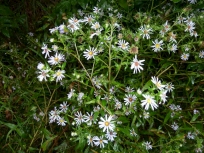
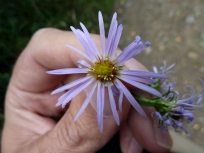 I tried to use the book,
Manual of Vascular Plants of Northeastern United States and Adjacent Canada to
“weed” through 66 different asters to find the one that matches these
pictures. It is a lot more difficult than it might seem. The way the book uses the
terms, cordate-clasping and auriculate-clasping adds to the confusion
(since they claim this plant is strong auriculate-clasping, but my pictures
and other “official” pictures of this plant do not seem to meet the exact
definition of those terms).
I tried to use the book,
Manual of Vascular Plants of Northeastern United States and Adjacent Canada to
“weed” through 66 different asters to find the one that matches these
pictures. It is a lot more difficult than it might seem. The way the book uses the
terms, cordate-clasping and auriculate-clasping adds to the confusion
(since they claim this plant is strong auriculate-clasping, but my pictures
and other “official” pictures of this plant do not seem to meet the exact
definition of those terms).
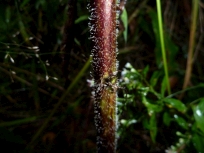
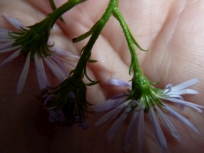 I narrowed my search down to three plants:
I narrowed my search down to three plants:
- New York Aster (Symphyotrichum novi-belgii)
- White Panicle Aster (Eastern Lined Aster) (Symphyotrichum lanceolatum var. simplex)
- Purplestem Aster (Swamp Aster, Bristly Aster (Symphyotrichum puniceum)
I eliminated New York Aster because its stem is either hairless or has short, fine hairs.
This plant has medium-long, spreading hairs on the stem.
The White Panicle Aster can have white, blue or lavender flowers and the
simplex variation that does grow in New Hampshire has leaves up to
3.5 cm wide. If the leaves would be considered not auriculate-clasping,
this plant would be a possible match. However, White Panicle Aster flower bracts
range from 3 to 6 mm, but this plant has flower bracts that are 7 mm. On the
White Stem Panicle, the bracts are imbricate (they overlap like shingles), but
in this plant, very few of the bracts overlap.
The rays of the on the White Stem Panicle flower grow 4.5 to 12 mm, but this
plant has rays that grow over 13 mm. The stem on White Panicle Aster grows up
to 1.5 meters (although some books say that the stem can be up to 8 feet long),
but the stem on this plant is 1.7 meters. The stem on White Panicle Aster is
“pubescent in lines above” (whatever the @*#%! that means! -- I will
guess that it means that there are single lines of hairs on the upper part of the stem
only and then the rest of the stem ... it’s anyone’s guess).
Purplestem Aster seemed the better match other than two issues:
- The leaves do not appear to me to be auriculate-clasping (earlike lobes
at the base of the leaf encircling the stem). The
leaves appear to be slightly decurrent (extending downward along the stem)
and only slightly clasping. Because the leaf extends downward along the stem,
it makes it appear to more strongly clasp the stem. Here is a picture from the
USDA Site of Purplestem Aster. If you look at a picture of the leaf not
on the stem from the
University of Wisconsin Herbarium, you can see that the
leaf does not have significant lobes to strongly clasp the stem.
- The other issue is that Purplestem Aster is supposed to has 30 to 60 flower
rays per flower. Many of the flowers I saw had in the mid 20’s for the
number of rays. I think some may be falling off, though. I'll go back and
look at more flowers tomorrow before I can be sure if these flowers usually
have 30 to 60 flower rays.
September 16, 2011
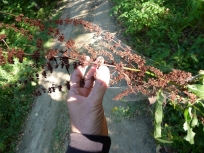
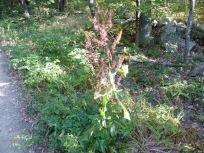 Bitter Dock is easy to recognize in flower. Notice that the copper-colored inflorescence
is not nearly as dark as the dark brown Curly Dock (Rumex crispus) inflorescence.
Bitter Dock is one of the few Docks in the Northeastern United States that has
valves margins (edges) with slender spines or teeth and with a single
prominent grain inside the valve. See the closeup of the values in the third row of
pictures.
Bitter Dock is easy to recognize in flower. Notice that the copper-colored inflorescence
is not nearly as dark as the dark brown Curly Dock (Rumex crispus) inflorescence.
Bitter Dock is one of the few Docks in the Northeastern United States that has
valves margins (edges) with slender spines or teeth and with a single
prominent grain inside the valve. See the closeup of the values in the third row of
pictures.
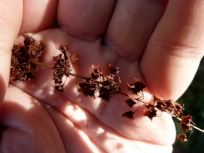
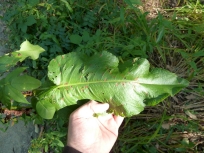
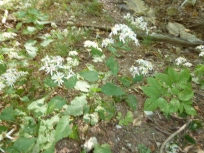
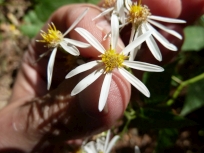 There are approximately 66 different Asters in the Northeastern United States.
Fortunately, there are only four (4) Asters that meet the following two criteria:
There are approximately 66 different Asters in the Northeastern United States.
Fortunately, there are only four (4) Asters that meet the following two criteria:
- Have leaves with petioles (leaf stems)
- Inflorescence (cluster of flowers) is commonly flat- or round-topped with
few firm and wide leafy bracts (reduced leaf structure at base of flower).
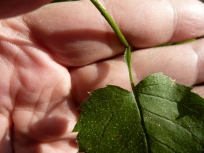
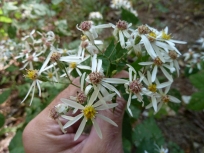 The following Asters meet this criteria:
The following Asters meet this criteria:
- Forked Aster (Midwestern White Heart-Leaved Aster) (Eurybia furcata):
This Aster does not grow East of Michigan.
- Big-Leaved Aster (Eurybia macrophylla): The flower has 9-20 rays. These
flowers had mostly 8 rays. The leaves of Big-Leaved Aster are Obtuse (Blunt rounded) or
Short-Acuminate (they taper to a relatively short point). The leaves of this plant are
Long-Acuminate (they taper to a fairly long point). Flowers tinged with lilac or purple.
- Schreber's Aster (Eurybia schreberi): Similar leaves to Big-Leaved Aster
above except that the basal leaves tend to have a rectangular sinus (at the base of the
leaf). Flower rays are 6-14 per flower. The involucre (whorl of bracts below the flower)
is much thinner than for Big-Leaved Aster.
- White Wood Aster (Common White Heart-Leaved Aster) (Eurybia divaricata):
This plant. Heart-shaped leaves, but only small notch where petiole meets leaf blade.
Leaves are shaply-toothed. They have a winged petiole. Leaf blad hairy, especially
appressed hairs on the veins of the underside of the leaf. Upper leaves are sessile (no
petioles) and often untoothed. Flower stalks have hairs, but the main plant stem was not
hairy on this plant. 5-10 rays on flower, but this plant consistently had 8. Bracts
imbricate (overlapping like shingles), green-tipped and the involucre (whorl of bracts
below flower) tend to be somewhat white.
September 18, 2011
Schreber’s Aster (Eurybia schreberi) (Synonym: Aster schreberi)
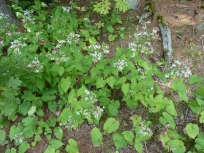
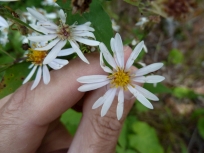 There are approximately 66 different Asters in the Northeastern United States.
Fortunately, there are only four (4) Asters that meet the following two criteria:
There are approximately 66 different Asters in the Northeastern United States.
Fortunately, there are only four (4) Asters that meet the following two criteria:
- Have leaves with petioles (leaf stems)
- Inflorescence (cluster of flowers) is commonly flat- or round-topped with
few firm and wide leafy bracts (reduced leaf structure at base of flower).
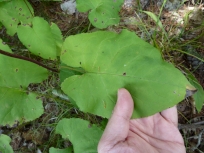
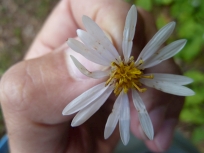 The following Asters meet this criteria:
The following Asters meet this criteria:
- Forked Aster (Midwestern White Heart-Leaved Aster) (Eurybia furcata):
This Aster does not grow East of Michigan.
- White Wood Aster (Common White Heart-Leaved Aster) (Eurybia divaricata):
The flower has 5-10 rays. These flowers had mostly 12 rays. The leaves of White Wood Aster
are Long-Acuminate (they taper to a relatively long point). The leaves of this plant are
Short-Acuminate (they taper to a fairly short point).
- Big-Leaved Aster (Eurybia macrophylla): The flower has
9-20 rays. The leaves of Big-Leaved Aster are Obtuse (Blunt rounded) or Short-Acuminate
(they taper to a relatively short point). Flowers tinged with lilac or purple.
- Schreber’s Aster (Eurybia schreberi): This plant. Similar leaves
to Big-Leaved Aster above except that the basal leaves tend to have a rectangular sinus
(at the base of the leaf). Flower rays are 6-14 per flower (though I have seen
some references listing as many as 20 rays). The involucre (whorl of
bracts below the flower) is much thinner than for Big-Leaved Aster.
This plant had some flowers that had as many as 16 rays. The bracts seems to be fairly
wide. Based on these two facts, Big-Leaved Aster would be a good fit. However, Big-Leaved
Aster flowers tend to be tinted purple or lilac. These flowers are white. In addition,
the involucre is 6 to 7 mm long and Big-Leaved Aster involucres are at least 7 mm long.
The sinus of the basal leaves was often rectangular as seen for Schreber’s Aster.
This plant is puberulent (fine, short hairs) on the peduncle (flower stalk) and not
does not appear to have glands on the peduncle. Big-Leaved Aster is glandular and
Schreber’s Aster is not glandular. Scheber’s Aster may be a hybrid
of Big-Leaved Aster and White Wood Aster, so some similarities of each are expected.
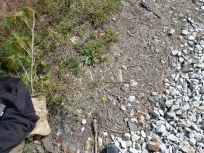
 I would not have expected to find Yellow Salsify still in bloom this late in the
year. Notice how the green bracts extend a long ways beyond the flower rays. Also,
notice on the closed flowerhead that the transition from the flowerhead to the
flower stalk is a gradual taper. Finally, notice that the thin, grass-like leaves
do not curl backwards. These three items differentiate Yellow Salsify from Meadow
Salsify (Tragopogon pratensis) (Synonym: Tragopogon lamottei).
I would not have expected to find Yellow Salsify still in bloom this late in the
year. Notice how the green bracts extend a long ways beyond the flower rays. Also,
notice on the closed flowerhead that the transition from the flowerhead to the
flower stalk is a gradual taper. Finally, notice that the thin, grass-like leaves
do not curl backwards. These three items differentiate Yellow Salsify from Meadow
Salsify (Tragopogon pratensis) (Synonym: Tragopogon lamottei).
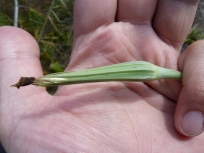
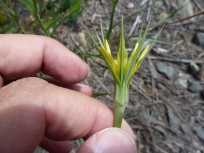
September 19, 2011
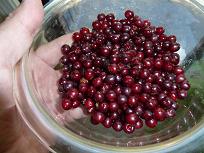 Chokecherry harvest. They are very tasty as long as given plenty of time to ripen (or even over-ripen).
I did not find enough to make jam.
Chokecherry harvest. They are very tasty as long as given plenty of time to ripen (or even over-ripen).
I did not find enough to make jam.
September 22, 2011
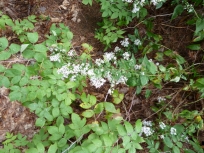
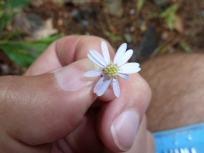
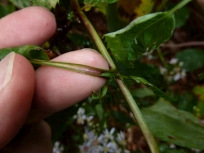
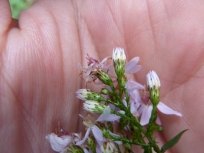
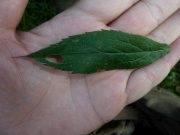
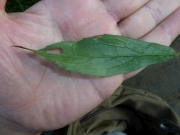
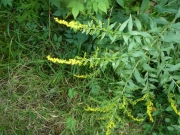
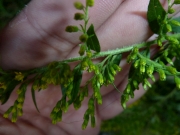
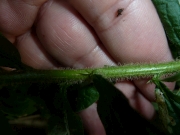
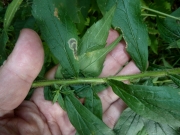
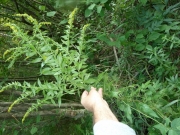
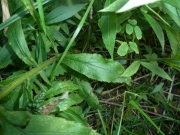

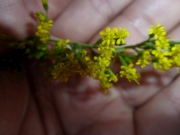

 In New England, there are only three triple-nerved goldenrods (3 main leaf veins)
where the leaf size and shape are nearly the same all of the way up and down the stem.
In New England, there are only three triple-nerved goldenrods (3 main leaf veins)
where the leaf size and shape are nearly the same all of the way up and down the stem.

 Giant Goldenrod has a smooth, hairless, glaucous (whitish, waxy coating) stem. Leaves
are hairless except for the three main veins on the underside of the leaf. Tall Goldenrod
is classified as one of the variations of Canada Goldenrod. Var. canadensis
and Var. salebrosa are sparsely hairly on the upper half of the stem and the
lower half is mostly hairless. Var. gilvocanescens has leaves that are spreading
hairly on the upper and lower surfaces and the leaves are 3.5 to 7 cm long.
Var. scabra and Var. hargeri have leaves over 7 cm long, stems are very
hairy throughout and upper surface of leaves merely rough to the touch, but not very hairy.
Var. scabra has larger and fewer disk flowers than Var. hargeri. Flower
rays average 13, leaves are firm and shallowly-toothed or entire (untoothed). Var.
hageri has thin leaves that are sharply toothed and sometimes entire.
Giant Goldenrod has a smooth, hairless, glaucous (whitish, waxy coating) stem. Leaves
are hairless except for the three main veins on the underside of the leaf. Tall Goldenrod
is classified as one of the variations of Canada Goldenrod. Var. canadensis
and Var. salebrosa are sparsely hairly on the upper half of the stem and the
lower half is mostly hairless. Var. gilvocanescens has leaves that are spreading
hairly on the upper and lower surfaces and the leaves are 3.5 to 7 cm long.
Var. scabra and Var. hargeri have leaves over 7 cm long, stems are very
hairy throughout and upper surface of leaves merely rough to the touch, but not very hairy.
Var. scabra has larger and fewer disk flowers than Var. hargeri. Flower
rays average 13, leaves are firm and shallowly-toothed or entire (untoothed). Var.
hageri has thin leaves that are sharply toothed and sometimes entire.










 There are only a handful of plants I can find listed as growing in
New Hampshire that look anything like this one:
There are only a handful of plants I can find listed as growing in
New Hampshire that look anything like this one:

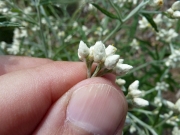
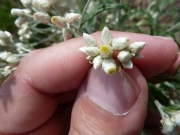
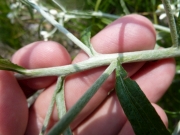
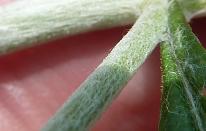
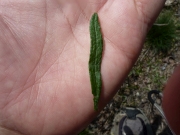
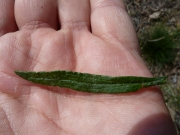
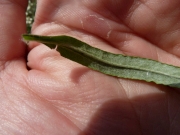
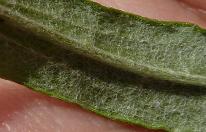
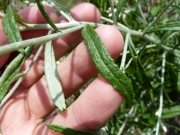
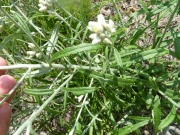

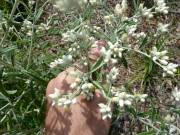
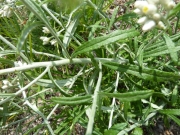
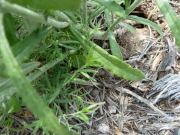
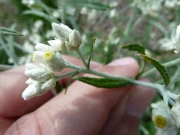

 In New Hampshire, there are only a few plants of the Bidens genus with odd
pinnately-compound leaves. That means that along each leaf is one or more sets of
opposite leaflets and the leaf ends in a terminal leaflet (making an odd number of
leaflets):
In New Hampshire, there are only a few plants of the Bidens genus with odd
pinnately-compound leaves. That means that along each leaf is one or more sets of
opposite leaflets and the leaf ends in a terminal leaflet (making an odd number of
leaflets):

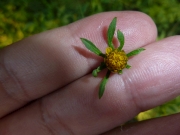
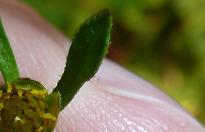
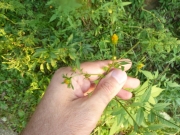

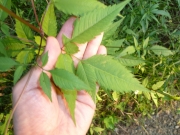
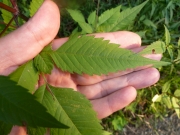
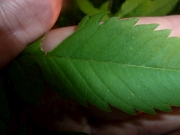
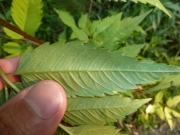
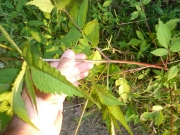

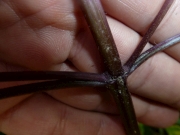
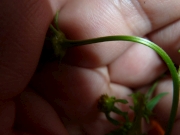




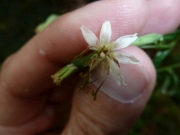
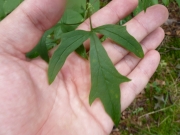
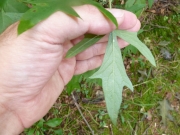





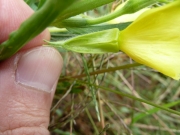
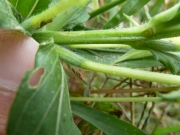
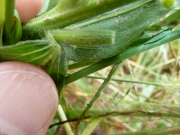
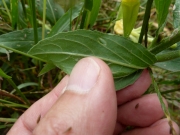
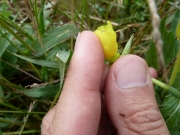

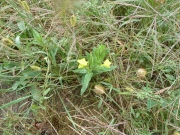

 The plants I encountered were 5 to 7 feet tall. In New Hampshire, there are only a few
species of Evening Primrose that are very tall (over 4 feet tall).
The plants I encountered were 5 to 7 feet tall. In New Hampshire, there are only a few
species of Evening Primrose that are very tall (over 4 feet tall).

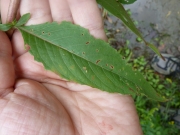
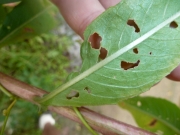
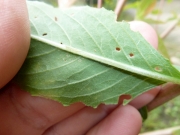
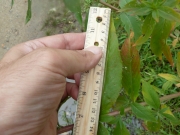
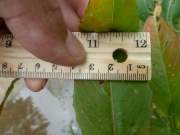
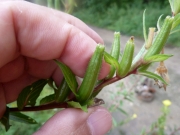
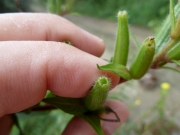
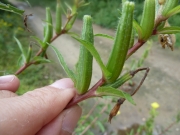
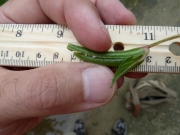
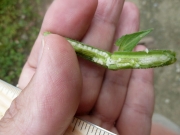
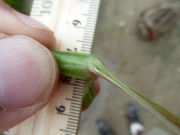
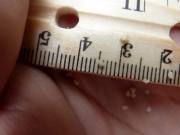
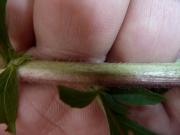
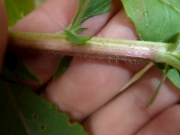
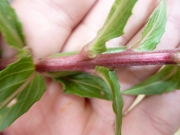
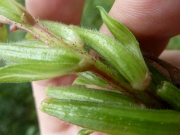
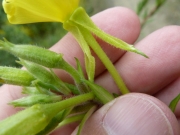
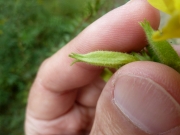
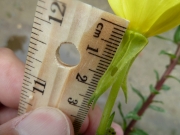
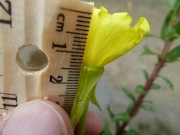
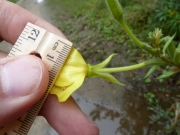
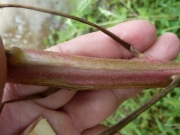
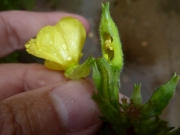
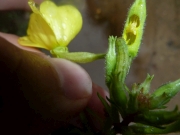

 I made 2-1/2 pints of Elderberry syrup following the
Mountain Rose Herbs
video instructions. I used 1/2 cup of honey on the second batch because it is too
sweet with 1 cup of honey per 1 cup of fresh elderberries.
I made 2-1/2 pints of Elderberry syrup following the
Mountain Rose Herbs
video instructions. I used 1/2 cup of honey on the second batch because it is too
sweet with 1 cup of honey per 1 cup of fresh elderberries.



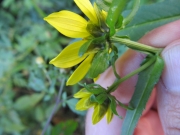
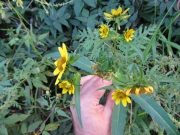
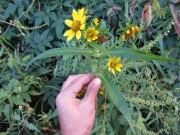
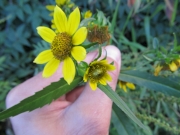
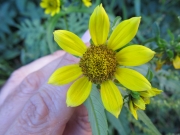
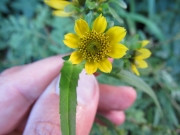
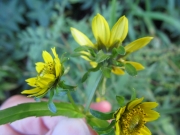
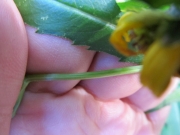
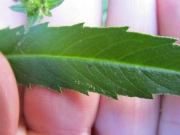
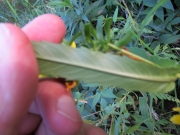
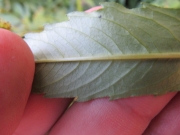
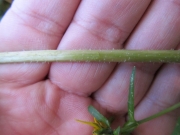
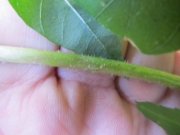
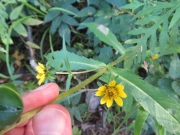
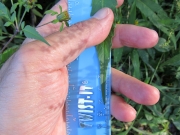
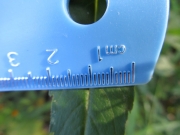
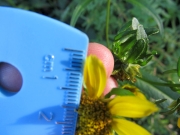
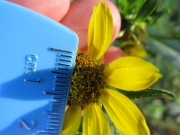
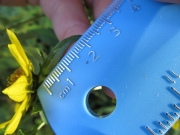
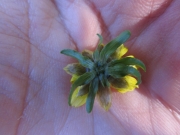

 In New Hampshire, there are only a few plants of the Bidens genus with odd
pinnately-compound leaves. That means that along each leaf is one or more sets of
opposite leaflets and the leaf ends in a terminal leaflet (making an odd number of
leaflets):
In New Hampshire, there are only a few plants of the Bidens genus with odd
pinnately-compound leaves. That means that along each leaf is one or more sets of
opposite leaflets and the leaf ends in a terminal leaflet (making an odd number of
leaflets):

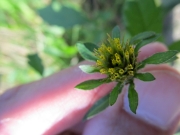
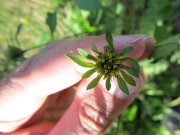
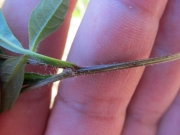
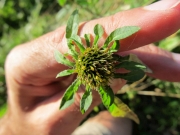
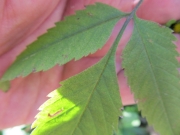
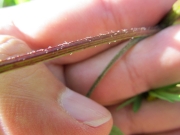
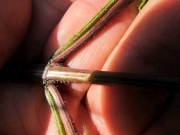
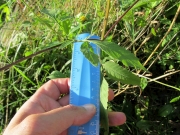
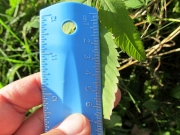
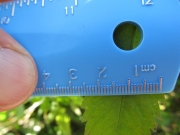
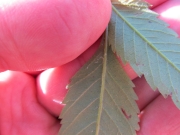
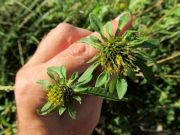
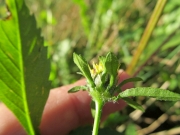
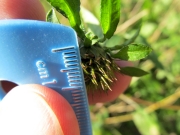
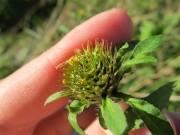
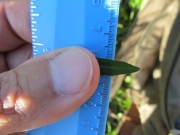
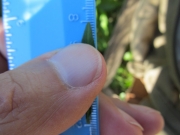




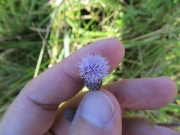
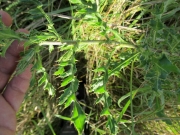
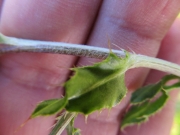
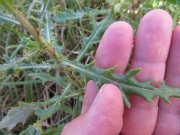
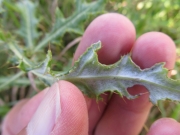
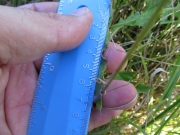

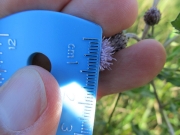
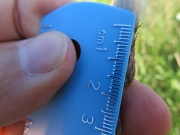
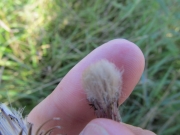

 The stem of this plant has an amazingly sticky feel due to the rows of tiny hooked
barbs. See the first image on the 2nd row below.
The stem of this plant has an amazingly sticky feel due to the rows of tiny hooked
barbs. See the first image on the 2nd row below.


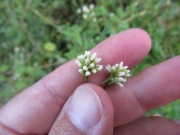
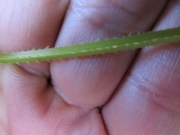
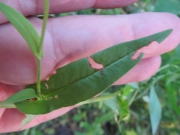
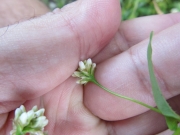
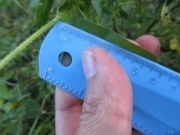
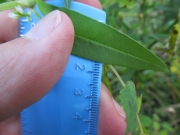
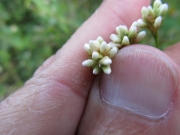




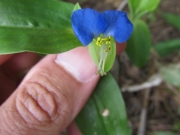
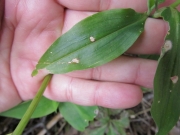
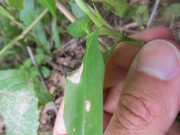
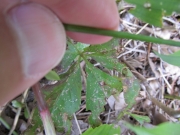
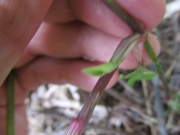




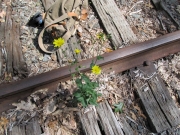
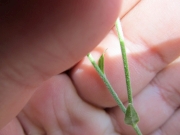
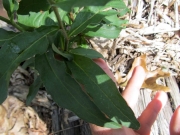
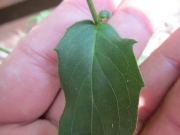
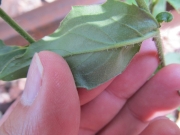
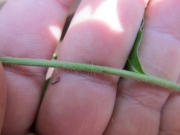
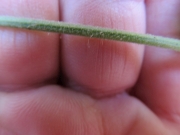
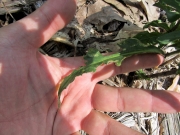




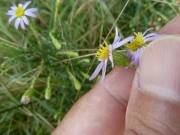
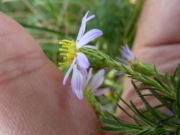
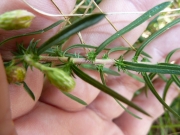
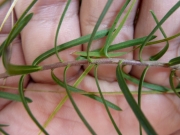
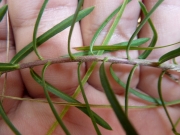
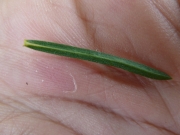
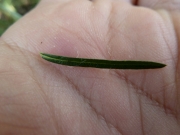
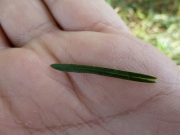
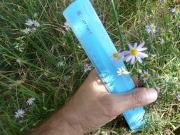
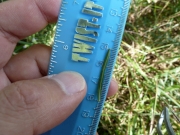
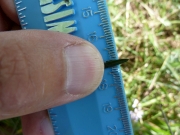
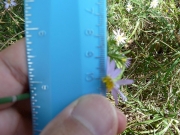
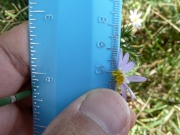


 This evening primrose had fruit that is round-angled (not squarish, sharply-angled like
Meadow Evening Primrose (Oenothera pilosella). The fruit is thickest near the
base and tapers. The flowers are yellow. This means that the plant was either
Common Evening Primrose (Oenothera biennis) (or one of its variations) or
Northern Evening Primrose (Oenothera pariflora) (or one of its variations). The
main differences appear to be the size of the seeds and how the two sepal appendages
connect to the sepal.
This evening primrose had fruit that is round-angled (not squarish, sharply-angled like
Meadow Evening Primrose (Oenothera pilosella). The fruit is thickest near the
base and tapers. The flowers are yellow. This means that the plant was either
Common Evening Primrose (Oenothera biennis) (or one of its variations) or
Northern Evening Primrose (Oenothera pariflora) (or one of its variations). The
main differences appear to be the size of the seeds and how the two sepal appendages
connect to the sepal.
 Looking at the picture on the left hand side of the 2nd row, it appears that the two
sepal appendances connect below the apex of the sepal. The apex of the sepal
is the point furthest away from where the sepal attaches to the flower. There is a
significant-sized ridge at the apex of the sepal and the appendances are attached
beneath that ridge.
Looking at the picture on the left hand side of the 2nd row, it appears that the two
sepal appendances connect below the apex of the sepal. The apex of the sepal
is the point furthest away from where the sepal attaches to the flower. There is a
significant-sized ridge at the apex of the sepal and the appendances are attached
beneath that ridge.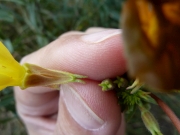
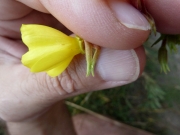
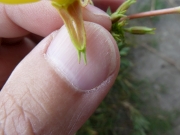
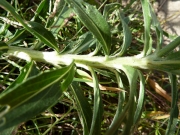
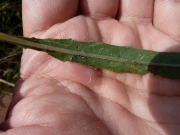
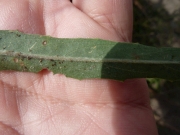
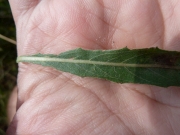
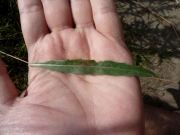
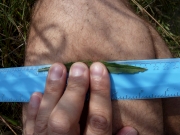
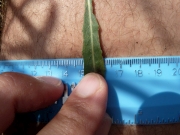
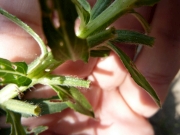
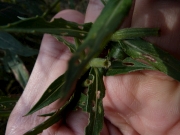
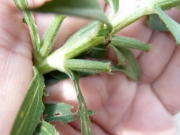
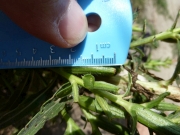
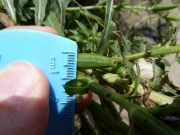
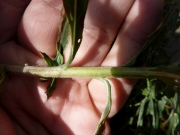
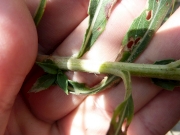
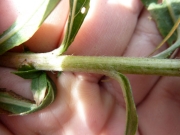
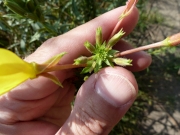
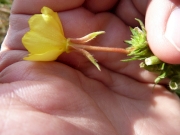
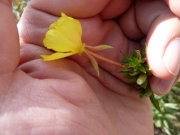
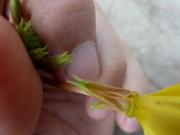
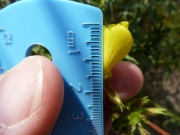
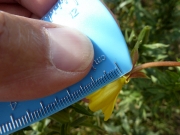
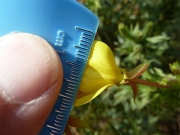
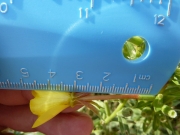
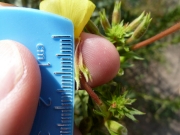
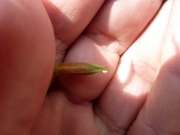
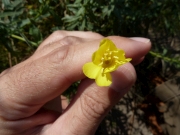
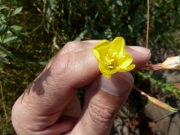
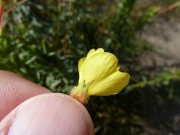
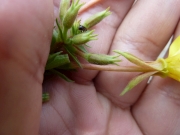
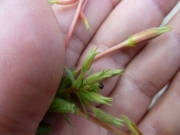
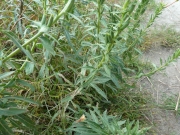
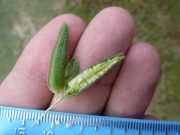
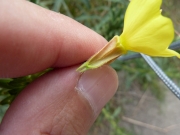

 I tried to use the book,
Manual of Vascular Plants of Northeastern United States and Adjacent Canada to
“weed” through 66 different asters to find the one that matches these
pictures. It is a lot more difficult than it might seem. The way the book uses the
terms, cordate-clasping and auriculate-clasping adds to the confusion
(since they claim this plant is strong auriculate-clasping, but my pictures
and other “official” pictures of this plant do not seem to meet the exact
definition of those terms).
I tried to use the book,
Manual of Vascular Plants of Northeastern United States and Adjacent Canada to
“weed” through 66 different asters to find the one that matches these
pictures. It is a lot more difficult than it might seem. The way the book uses the
terms, cordate-clasping and auriculate-clasping adds to the confusion
(since they claim this plant is strong auriculate-clasping, but my pictures
and other “official” pictures of this plant do not seem to meet the exact
definition of those terms).
 I narrowed my search down to three plants:
I narrowed my search down to three plants: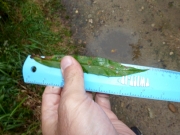
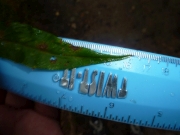
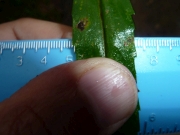
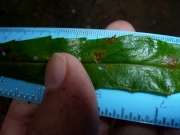
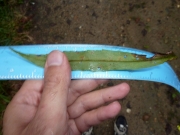
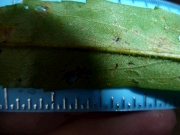
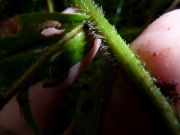
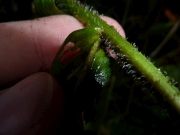
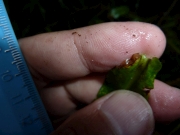
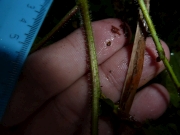

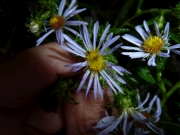
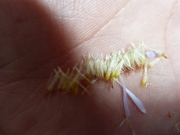
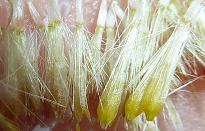
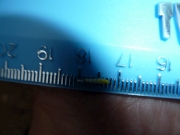
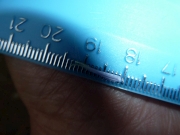
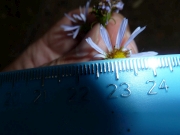
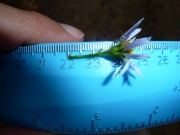
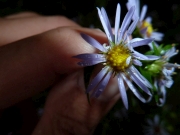
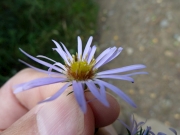
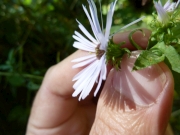
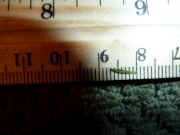
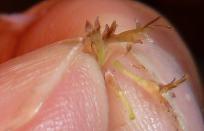
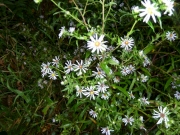
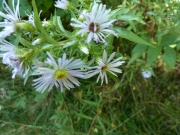
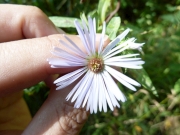
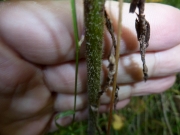
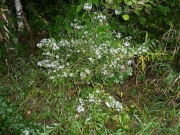
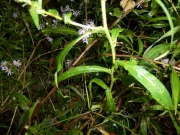
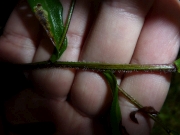
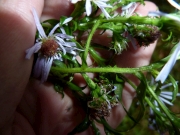

 Bitter Dock is easy to recognize in flower. Notice that the copper-colored inflorescence
is not nearly as dark as the dark brown Curly Dock (Rumex crispus) inflorescence.
Bitter Dock is one of the few Docks in the Northeastern United States that has
valves margins (edges) with slender spines or teeth and with a single
prominent grain inside the valve. See the closeup of the values in the third row of
pictures.
Bitter Dock is easy to recognize in flower. Notice that the copper-colored inflorescence
is not nearly as dark as the dark brown Curly Dock (Rumex crispus) inflorescence.
Bitter Dock is one of the few Docks in the Northeastern United States that has
valves margins (edges) with slender spines or teeth and with a single
prominent grain inside the valve. See the closeup of the values in the third row of
pictures.

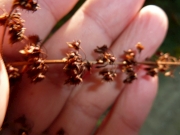
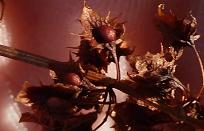
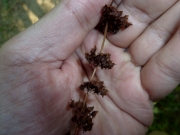
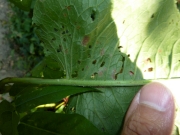

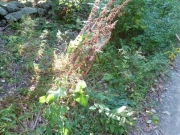
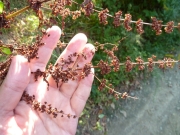
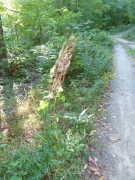
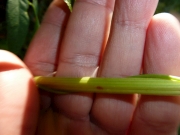

 There are approximately 66 different Asters in the Northeastern United States.
Fortunately, there are only four (4) Asters that meet the following two criteria:
There are approximately 66 different Asters in the Northeastern United States.
Fortunately, there are only four (4) Asters that meet the following two criteria:
 The following Asters meet this criteria:
The following Asters meet this criteria: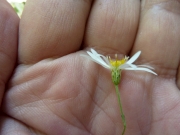
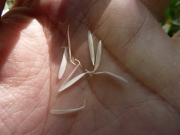
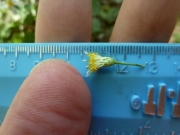
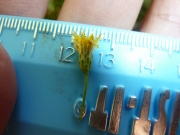
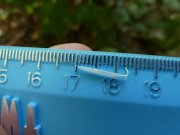
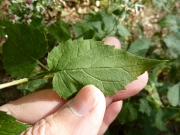
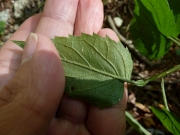
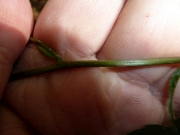
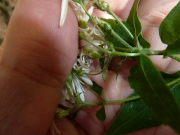
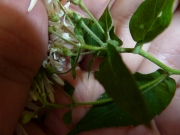
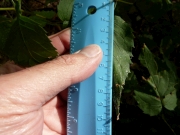

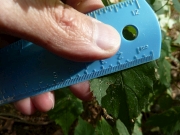
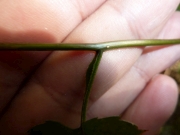
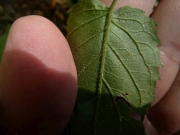
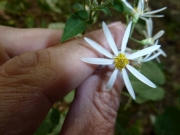
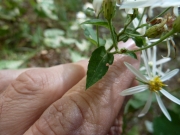
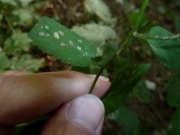
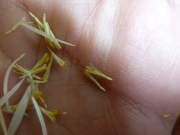
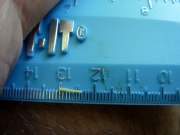

 There are approximately 66 different Asters in the Northeastern United States.
Fortunately, there are only four (4) Asters that meet the following two criteria:
There are approximately 66 different Asters in the Northeastern United States.
Fortunately, there are only four (4) Asters that meet the following two criteria:
 The following Asters meet this criteria:
The following Asters meet this criteria: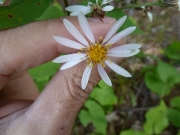
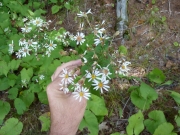
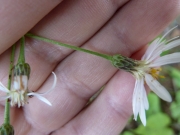
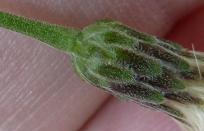
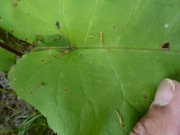
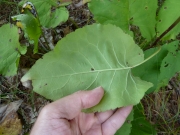
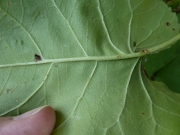
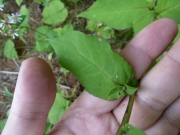
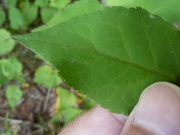
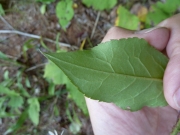
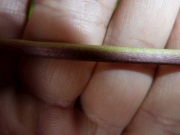

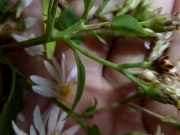
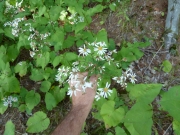
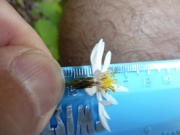
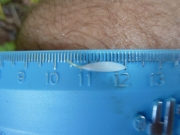
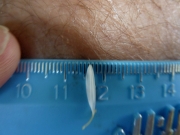
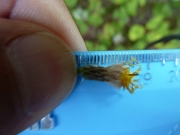
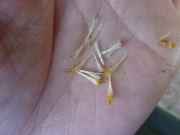
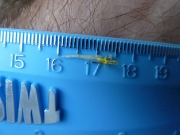
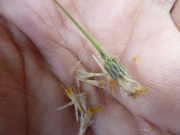
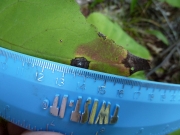
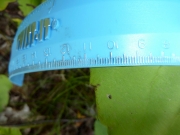
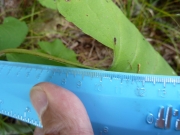
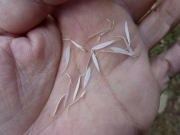
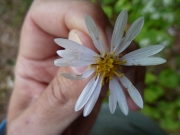

 I would not have expected to find Yellow Salsify still in bloom this late in the
year. Notice how the green bracts extend a long ways beyond the flower rays. Also,
notice on the closed flowerhead that the transition from the flowerhead to the
flower stalk is a gradual taper. Finally, notice that the thin, grass-like leaves
do not curl backwards. These three items differentiate Yellow Salsify from Meadow
Salsify (Tragopogon pratensis) (Synonym: Tragopogon lamottei).
I would not have expected to find Yellow Salsify still in bloom this late in the
year. Notice how the green bracts extend a long ways beyond the flower rays. Also,
notice on the closed flowerhead that the transition from the flowerhead to the
flower stalk is a gradual taper. Finally, notice that the thin, grass-like leaves
do not curl backwards. These three items differentiate Yellow Salsify from Meadow
Salsify (Tragopogon pratensis) (Synonym: Tragopogon lamottei).


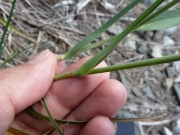
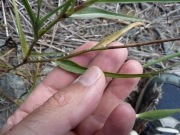
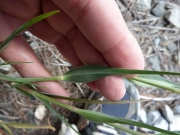
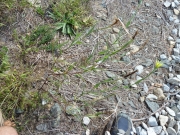
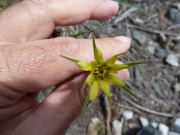
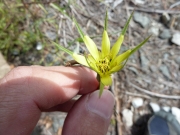
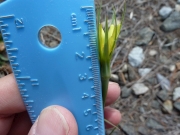
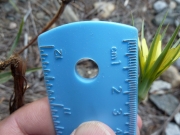

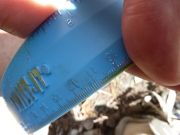
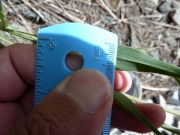
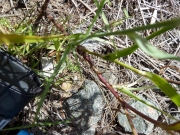
 Chokecherry harvest. They are very tasty as long as given plenty of time to ripen (or even over-ripen).
I did not find enough to make jam.
Chokecherry harvest. They are very tasty as long as given plenty of time to ripen (or even over-ripen).
I did not find enough to make jam.



